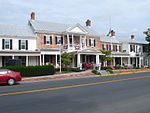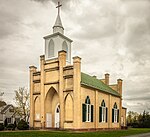Belle Grove Plantation (Middletown, Virginia)

Belle Grove Plantation is a late-18th-century plantation house and estate in the northern Shenandoah Valley of Virginia, USA. It is situated in Frederick County, about a mile southwest of Middletown. Built between 1794 and 1797, the large Federal-style manor house is a National Historic Landmark and was opened to the public by its owners, the National Trust for Historic Preservation (NTHP), as a historic house museum in 1967. In 2002, Belle Grove became part of the Cedar Creek and Belle Grove National Historical Park, a National Park Service unit, although it continues to be owned and operated by the NTHP. It is part of a U.S. National Historic Landmark, the Cedar Creek Battlefield and Belle Grove Plantation. Belle Grove is also designated a Virginia Historic Landmark and, as part of 900-acre (3.6 km2) "Cedar Creek Battlefield and Belle Grove", is listed on the National Register of Historic Places. Historically important as the home of revolutionary veteran Major Isaac Hite, Jr – President James Madison’s brother-in-law – and as the headquarters of General Philip Sheridan during the Battle of Cedar Creek (1864), the manor house has been little altered over the centuries and remains one of the best preserved 18th century homes in the country. Affording grand vistas of the surrounding Shenandoah Valley, Blue Ridge and Alleghenies, the estate is situated on 283 acres of Maj. Hite’s original 483 acres. (The entire CCBGNHP, including the nearby battlefield, consists of 3,593 acres.)
Excerpt from the Wikipedia article Belle Grove Plantation (Middletown, Virginia) (License: CC BY-SA 3.0, Authors, Images).Belle Grove Plantation (Middletown, Virginia)
Belle Grove Road,
Geographical coordinates (GPS) Address Nearby Places Show on map
Geographical coordinates (GPS)
| Latitude | Longitude |
|---|---|
| N 39.019444444444 ° | E -78.304166666667 ° |
Address
Belle Grove Road
Belle Grove Road
22645
Virginia, United States
Open on Google Maps







